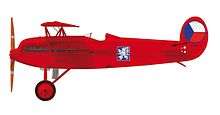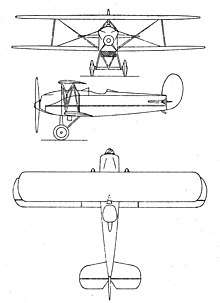Avia BH-21
The Avia BH-21, first flown in 1925, was a robust biplane that served an important role in securing Czechoslovak national security during the period between World War I and World War II. As well as being a competent fighter, it was also an accomplished racer, winning several air races in 1925.

| BH-21 | |
|---|---|
 | |
| Role | Fighter |
| Manufacturer | Avia |
| Designer | Pavel Beneš and Miroslav Hajn |
| First flight | January 1925 |
| Number built | 184 |
Development
The Avia BH-17, a conventional biplane which was the predecessor of the BH-21, was designed by Pavel Beneš and Miroslav Hajn in 1922 as a response to a Czechoslovak Defense Department requirement for a new fighter aircraft. The BH-17 was one of three biplanes amongst the five Avia designs submitted to the Defense Department, along with competing designs from the Letov Kbely and Aero companies. After an extensive review, the BH-17 was chosen and limited production initiated for evaluative purposes. Testing revealed some deficiencies in the BH-17 and a subsequent redesign in 1924 morphed the BH-17 into its final form as the BH-21, which included straightened interplane bracing and allowed for a better field of view for the pilot. A special training version, designated the BH-22, was also created. Both versions utilized Hispano-Suiza V8 engines, the BH-22 the less powerful 180 HP version, the BH-21 the 224 kW (300 hp) Hispano-Suiza 8fb , built under license by Škoda.
The BH-21 was put into production by Avia in 1925, giving one hundred and thirty-nine aircraft for the Czechoslovak Air Force. In June 1925 it was successful in trials staged by the Belgian Air Force. One was built for Belgium by Avia, another thirty-nine were produced under license by the Belgian company, Société Anonyme Belge de Constructions Aéronautiques SABCA and five by the Société d'Etudes Général d'Aviation SEGA.[1]
While in service, the BH-21 saw no combat as it was retired long before the outbreak of World War II. In spite of this, it served as an important stepping stone to the more advanced BH-33 and B-34 types.
There were also two experimental variants: the BH-21J with Jupiter engine (predecessor of BH-33) and a race plane, the BH-21R, with a boosted HS-8Fb engine (298 kW/400 hp). The latter won several national air race competitions in 1925.
Variants
- BH-21 : Single-seat fighter aircraft.
- BH-21J : One BH-21 fitted with a Bristol Jupiter radial piston engine. Led to the development of the Avia BH-33.
- Bh-21R : Single-seat clipped-wing racing aircraft.
Specifications

Data from Les Ailes, May 1925[2]
General characteristics
- Crew: One
- Length: 6.87 m (22 ft 6 in)
- Wingspan: 8.90 m (29 ft 2 in) upper wing slightly less
- Height: 2.74 m (9 ft 0 in)
- Wing area: 22 m2 (240 sq ft)
- Empty weight: 765 kg (1,687 lb)
- Gross weight: 1,075 kg (2,370 lb)
- Fuel capacity: 140 kg (310 lb)
- Powerplant: 1 × Hispano-Suiza 8Fb V-8 water-cooled piston engine, 224 kW (300 hp) at 1,850rpm
- Propellers: 2-bladed
Performance
- Maximum speed: 250 km/h (160 mph, 130 kn)
- Stall speed: 90 km/h (56 mph, 49 kn)
- Range: 600–650 km (370–400 mi, 320–350 nmi)
- Time to altitude: 7,000 m (23,000 ft) in 35 min
Armament
- Guns: 2 × 7.7 mm (0.303 in) Vickers machine guns in the upper front fuselage.[1]
References
- Green, William; Swanborough, Gordon (1994). The Complete Book of Fighters. Godalming, UK: Salamander Books. p. 33-35. ISBN 1-85833-777-1.
- Serryer, \J. (21 May 1926). "L'avion de chasse Avia". Les Ailes (205): 2–3.